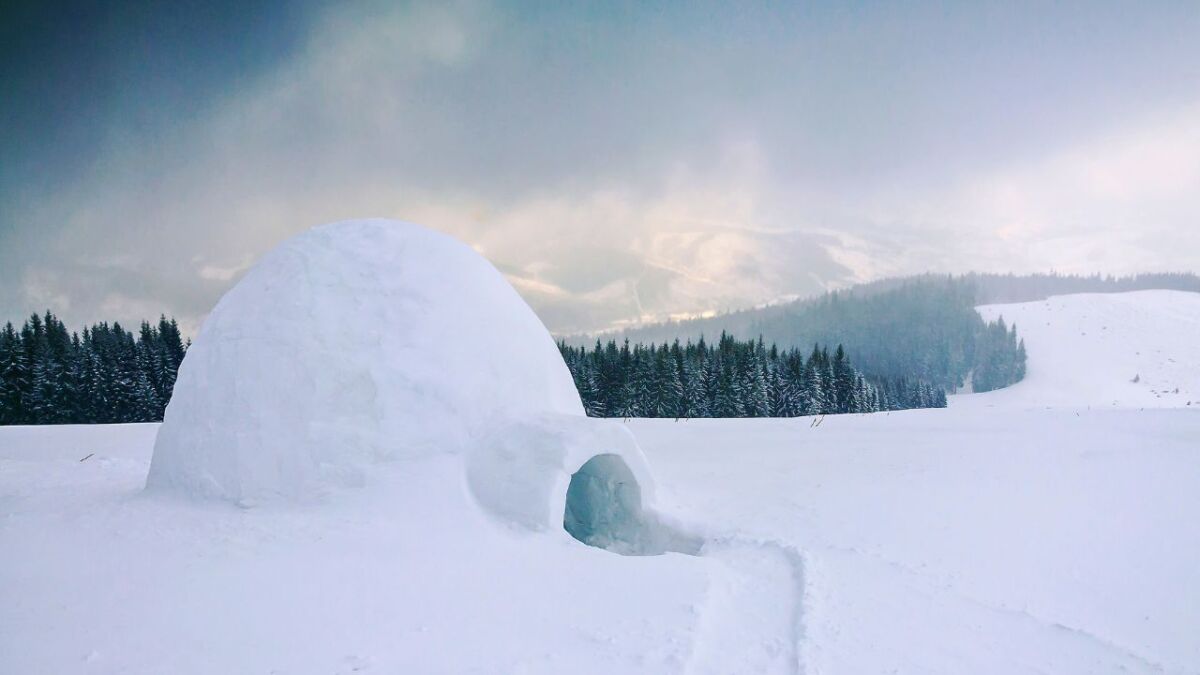
Igloo
Noun
Meaning
An igloo is a traditional Inuit shelter made of compacted snow blocks. It is a dome-shaped structure that provides excellent insulation and protection against extreme cold weather conditions. In the context of survival, bushcraft, and wilderness activities, an igloo can be a lifesaver, especially in snowy environments. Building an igloo requires specific knowledge and skills, including selecting the right snow, carving and stacking the blocks, and creating a ventilation hole. Igloos are not only functional but also culturally significant, representing the ingenuity and resourcefulness of indigenous Arctic peoples. They are also popular among winter campers and adventurers seeking unique outdoor experiences.

Examples
„I love building igloos in the winter. It's a great way to stay warm and protected from the elements.“
„During our winter survival training, we learned how to construct an igloo using only snow and a shovel.“
„When we were stranded in the snowstorm, we quickly built an igloo to seek shelter and wait for rescue.“
„The Inuit people have been living in igloos for centuries, using them as temporary homes during their hunting trips.“
„Igloos are not just for winter survival, they can also be used as a cool shelter in hot desert environments.“
Origin
The word "igloo" originates from the Inuit language, specifically from the Inuktitut word "iglu" which means "house" or "shelter". The Inuit people are indigenous to the Arctic regions of Canada, Greenland, and Alaska.
Iglus are traditional dome-shaped structures made of compacted snow blocks. They were originally built by the Inuit as temporary winter shelters during hunting and fishing expeditions. The design of the igloo allows it to retain heat and provide insulation against the harsh Arctic cold.
Over time, the term "igloo" has come to be associated with any dome-shaped snow shelter, even though the traditional Inuit igloos were made exclusively from snow. Today, igloos are often used as tourist accommodations in Arctic regions, and modern versions can be constructed using materials other than snow, such as wood or metal.
The concept of the igloo has also influenced modern architecture and design, with its unique shape and efficient use of materials inspiring innovative building techniques.
Historical and cultural importance
The word "igloo" originates from the Inuit language and refers to a traditional type of shelter made from blocks of compacted snow. Historically, igloos have been used by the indigenous Inuit people of the Arctic regions as temporary winter dwellings. These structures are not only functional but also hold significant cultural and historical importance.
Igloos are ingeniously designed to provide insulation and protection against the harsh Arctic climate. The dome-shaped structure helps to trap heat inside, creating a warm and comfortable living space. The thick walls of snow act as excellent insulators, keeping the interior temperature relatively stable despite the freezing temperatures outside.
For the Inuit people, igloos have been an integral part of their nomadic lifestyle, allowing them to move and adapt to different hunting grounds. The construction of an igloo requires specialized knowledge and skills, passed down through generations. It involves carefully selecting and cutting blocks of snow, arranging them in a spiral pattern, and using a mixture of snow and ice as mortar to hold the blocks together.
Today, while modern materials and technologies have replaced traditional igloos in many Arctic communities, the cultural significance of these structures remains strong. Igloos symbolize the resilience, resourcefulness, and deep connection to the natural environment that the Inuit people have developed over centuries. They serve as a reminder of the rich cultural heritage and survival skills of the indigenous Arctic communities.
More information about the term Igloo
Building an Igloo: The Ultimate Winter Shelter
When it comes to surviving in extreme winter conditions, few shelters are as effective as an igloo. This traditional Inuit dwelling has been used for centuries to provide warmth and protection in the harshest of environments. In this article, I'll guide you through the process of building an igloo, step by step.
Gathering the Right Materials
The first step in constructing an igloo is gathering the necessary materials. You'll need compacted snow, preferably with a high water content, as it will freeze and bond together more effectively. A snow saw or shovel will come in handy for cutting blocks of snow.
Creating the Foundation
To start building your igloo, choose a flat and level area. Begin by marking a circle on the ground, using a rope or any other suitable material. This will serve as the foundation for your shelter. Dig a trench along the marked circle, about one to two feet deep, and pack the snow firmly to create a solid base.
Constructing the Walls
Now it's time to start building the walls of your igloo. Cut blocks of snow from the surrounding area and stack them in a circular pattern, gradually sloping inward as you go higher. Each block should be slightly tilted inward to create a dome shape. Use a mixture of snow and water to bond the blocks together securely.
Creating the Entrance
Leave a small opening at the base of the igloo for the entrance. This will help trap warm air inside while keeping cold air out. You can use a snow block or a piece of fabric to cover the entrance when needed.
Finishing Touches
Once the walls are complete, it's time to add the final touches to your igloo. Smooth out the interior walls using a snow knife or any other suitable tool. This will help improve insulation and create a more comfortable living space. You can also create a raised sleeping platform by packing snow and shaping it to your desired height.
Living in an Igloo
An igloo provides excellent insulation, keeping you warm even in freezing temperatures. However, it's important to remember that proper ventilation is crucial to prevent carbon dioxide buildup. Create a small vent at the top of the igloo to allow fresh air to circulate.
Building an igloo requires patience, skill, and attention to detail. It's a rewarding experience that connects you with ancient survival techniques and allows you to thrive in the winter wilderness. So, the next time you find yourself in a snowy landscape, consider building an igloo for a truly unique and cozy shelter.
Back to overview

